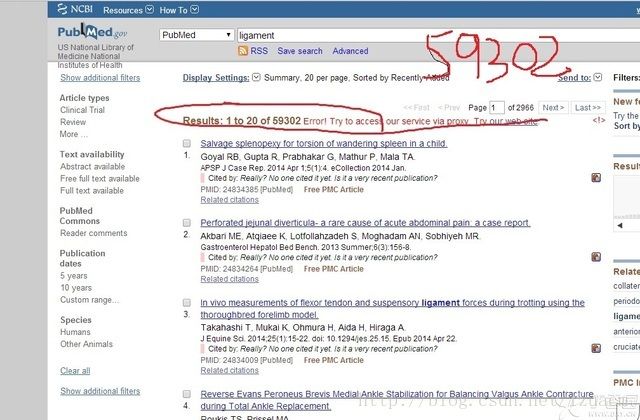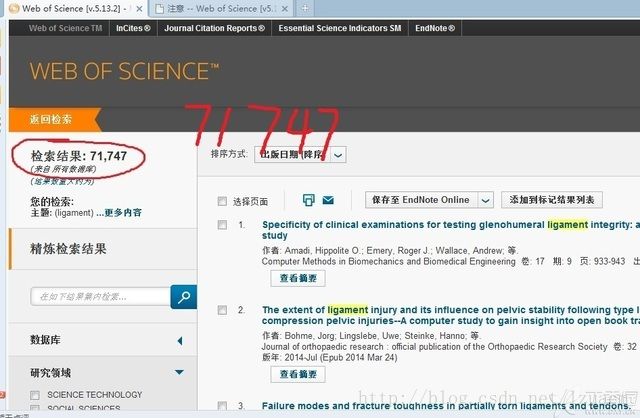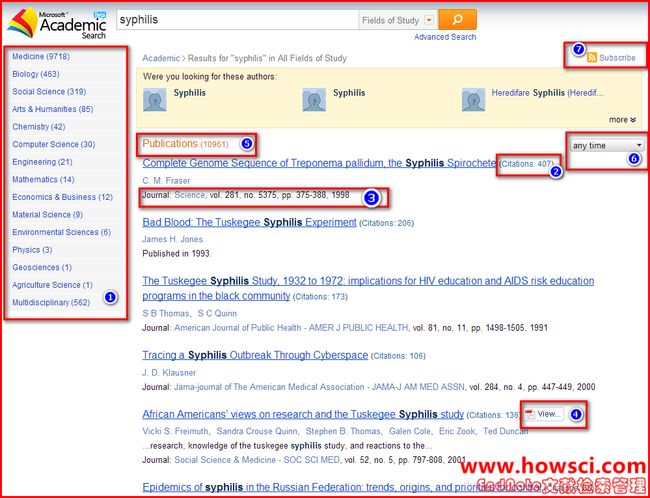新生搜索神器Microsoft Academic Search与Google scholar、PubMed、wos、embase大PK!
新生搜索神器Microsoft Academic Search与Google scholar、PubMed、wos、embase大PK!
微软学术搜索(Microsoft Academic Search)的服务器正在迅速扩张,试图覆盖所有学术领域。
初进MSAcademicSearch,简单大方的界面无疑是最吸引人的地方了,很干净而且有条理,这点比很多搜索引擎(Google Sscholar, Arnetminer)的好很多,给人的第一印象很好,应该能吸引挺多无意中逛到这来的用户,赞一下设计人员~
首先说说亮点,先扬后抑,嘻嘻:
1. 搜索框输入时支持逻辑连接(与、或),但是好像概念上存在模糊,不过这点已经能够满足一些特殊需求。
2. 每个author的Co-author graph做的不错,而且能切换到co-author的graph,界面也很炫,这点很赞,是一个很大的亮点~
不过开始使用后还是发现不少问题,有待改进:
1. 搜索框中输入时没有自动补全(automatic completion)功能,对于现在被惯坏了的用户来说这已经是个基本要求了,既方便了用户,同时也可以在无形中提高搜索量,因为可以向用户提供一些与其搜索目标比较接近但原来并不了解的选项。●下图为在MSAcademic、Google、Arnetminer搜索框中输入“shipeng”(搜索“shipeng li”)后的结果显示,Google和Arnetminer都有自动提示(都包含有“shipeng li”),而MSAcademic却没有。
 |
 |
 |
而作为体现搜索引擎个性化和智能化水平的高级搜索选项,MSAcademic的Advanced search实在让人大跌眼镜,几乎就和基本搜索无异。
●下图显示了MSAcademic和Google Scholar的高级搜索选项,MSAcademic (仅下左图中红色部分)又一次完败。
进而考虑根据用户的搜索目标进行一些相关推荐,比如根据其搜索的author的研究领域推荐该领域的其他著名author等,也就是希望能够做到投其所好,这对用户来说是个很不错的体验。
5. Paper下载的功能不够强大,显示不够清楚,很多链接点击进入后不能下载,这点应该要向用户明确是能下载全文还是只能看到摘要(通过PDF图标等),希望能够做到IP检测的功能,有权限进入数据库的用户就直接提供下载,否则转入相关会议或杂志的界面。
很早就发现了Microsoft Academic Search ,但是以前的它那样弱小,检索出的结果和Google scholar相比实在是小巫见大巫。所以基本没有,就等着微软将它发展壮大再用了,最近一看,虽然和其他数据库搜索引擎还有差距,但是自身已经长足进步!
最近就自己目前关心的生物力学中的ligament进行检索
虽然从数量上来说谷歌仍是第一,但是不知道你们有没有尝试过,谷歌的检索结果再多,也只能看到100页就在也看不了了。也就是说,其检索结果再多,你也只能看到20000条!
所以在质量上 我个人还无从评价!毕竟各个搜索引擎的检索规则不同!
这是今年science刊登的关于谷歌的帖子:谷歌搜索值得信赖吗?
http://www.sciencemag.org/content/343/6166/14.full
Science 3 January 2014:
Vol. 343 no. 6166 p. 14
DOI: 10.1126/science.343.6166.14
- NEWS & ANALYSIS
Google Scholar Wins Raves—But Can It Be Trusted?
- John Bohannon

View larger version:
In this page
In a new window
Download PowerPoint Slide for Teaching
At your service. Google Scholar anticipates researchers' interests.
CREDIT: ADAPTED FROM © PCANZO/ISTOCKPHOTO
Over the past year, Jonathan Eisen's reading habits have changed dramatically. For most of the past 2 decades, he has kept up with scientific literature primarily by combing PubMed, the vast trove of online biology abstracts. But these days Eisen, an evolutionary biologist at the University of California, Davis, discovers research relevant to his own work without even looking for it.
The insightful librarian helping keep Eisen up to speed is Google Scholar, a free academic search service maintained by the California-based company. Google Scholar has been studying Eisen closely. It keeps track not only of his own 300 papers and the key words within them—Archaea, Plasmodium, phylogenomics—but also the 38,000 citations to his work in published papers, preprint abstracts, books, and even conference posters. Like a scientific version of the Netflix movie recommendation engine, Google Scholar scours the Internet, scoring all scientific documents for their predicted interest to Eisen, and then sends him a weekly e-mail of recommended reading.
Eisen is part of growing crowd of converts. "Google Scholar is having a great impact on the research-seeking behavior of researchers," says Nicolás Robinson-Garcia, a bibliometric researcher at the University of Granada in Spain. Robinson-Garcia claims that Google Scholar's compendium of articles is at least as comprehensive as the leading commercial academic search databases—Thomson Reuters' Web of Science and Elsevier's Scopus—and for many disciplines in the social sciences and humanities, even better. And by all accounts, it is gobbling up market share. "Google is the dominant referral source for online journal articles, far surpassing the amount of traffic driven by other discovery tools," says David Crotty, senior editor at Oxford University Press in New York City.
But researchers aren't just using Google Scholar as a search engine. Its algorithm provides citation metrics that quantify the impact of their own published work, and these numbers are becoming part of a standard scientific CV. This byproduct of Google Scholar has sparked a new concern: Because it includes sources from across the Internet—not only vetted journals—and has no human curators, Google Scholar's citation metric can be easily gamed.
Robinson-Garcia is part of a team that demonstrated that vulnerability by placing six fake papers with long lists of citations to their own work on a webpage within the University of Granada Internet domain. Google Scholar's algorithm dutifully tallied them as real citations and in a matter of weeks, their Google Scholar citation scores rose significantly. The team's findings appeared online on 11 November in the Journal of the American Society for Information Science and Technology.
If Google Scholar were to provide a breakdown of the sources it tapped for its citation metric, Robinson-Garcia says, "our fraud could have been easily detected." That lack of transparency is a deal breaker for some bibliometric researchers, including Rodrigo Costas Comesa?a of Leiden University in the Netherlands; he calls Google Scholar "an unmanageable tool" for citation analysis.
Google counters that critics are overstating the problem. Anurag Acharya, a co-founder of Google Scholar who leads its development, labels efforts to skew the citation metric as "spam." So far, he says, "the level of spam in scholarly articles remains low." Acharya chalks this up to the "large penalty that would come with being caught" rigging the system in scholarly communities. But if social norms fail to keep academic cheaters in check, he says, "we can and will adjust the level of spam-handling." However, he says, Google has no intention of revealing its algorithm, in part because it is tied up with the company's core search engine.
Google Scholar's ascendance may soon be challenged. "Microsoft is still working in this area too," says Anne-Wil Harzing, the creator of Publish or Perish, a citation analysis tool that uses data from Google Scholar. A service called Microsoft Academic Search is expanding rapidly to cover all academic domains. Meanwhile, Thomson Reuters and Elsevier have a strong financial incentive to keep their services competitive. Many universities are bound by nondisclosure agreements, but Cornell University librarian John Saylor says his institution pays $155,000 per year for access to Web of Science. As Harzing says, "having both Google and Microsoft in this field will surely keep Thomson Reuters and Elsevier on their toes!"
Experts say the competition has another benefit: giving scientists options, so that they don't come to depend on just one service, such as Google Scholar, that may be vulnerable to corporate downsizing. There are "persistent rumors that Google is de-emphasizing or even dismantling the Scholar team," says John Sack, founding director of HighWire, an online publishing platform for more than 1300 journals, including Science. Although Google Scholar generates no direct income, Acharya is upbeat about its future. While he declines to reveal usage figures, he claims that the number of users is growing worldwide, particularly in China. And the Google Scholar team is expanding, not contracting, he says. "Rumors of our demise are greatly exaggerated."
Science:谷歌学术搜索值得信赖吗?
作者:koo
谷歌学术搜索逐渐引起了研究人员的使用兴趣。
在过去一年中,Jonathan Eisen 的阅读习惯发生了显著改变。在之前20年的大部分时间里,他主要通过梳理生物学摘要的在线数据库 PubMed 以了解科学文献。不过最近,身为美国加州大学戴维斯分校进化生物学家的 Eisen 不再从中搜寻资料,但却仍能找到与其工作相关的研究。
帮助 Eisen 实现这一效果的图书管理员就是谷歌学术搜索(Google Scholar),即由位于加州硅谷地区的科技巨头谷歌公司所开发的自由学术搜索服务。谷歌学术搜索密切关注着 Eisen 的研究,它不仅能够跟踪到 Eisen 自己的 300 篇论文及其关键词——古生菌、疟原虫等,还能找到发表的论文、预印摘要、书籍。谷歌学术搜索就像一个科学版的电影推荐引擎,搜索互联网,提供所有其预测会令 Eisen 感兴趣的科学文档,然后每周向他发送推荐阅读的电子邮件。
Eisen 是越来越多支持谷歌学术搜索的人群中的一员。西班牙格拉纳达大学的文献计量研究人员 Nicolas Robinson-Garcia 说:“谷歌学术搜索对研究人员的学术搜索行为有很大影响。” Robinson-Garcia 认为,谷歌学术搜索中的文献纲要至少与领先的商业学术搜索资料库——汤森路透科学网络(Thomson Reuters' Web of Science)和爱思唯尔的斯高帕斯数据库(Elsevier's Scopus)同样全面,在社会科学和人类学领域甚至比其做得更好。据说,谷歌学术搜索正在吞噬市场份额。牛津大学出版社高级编辑 David Crotty 说:“谷歌是在线期刊文章的主要推介来源,远远超过其他搜索工具。”
但研究人员并不只将谷歌学术搜索作为搜索引擎。其算法提供了引文指标,可以量化他们发表的作品的影响,而且这些数字逐渐成为了标准科学简历的一部分。谷歌学术搜索的这一副产品引发了一个新担忧:因为它涵盖了互联网上的数据来源,而不只来自审查期刊,但却没有管理者,因此谷歌学术搜索的量化引用很容易被人操纵。
Robinson-Garcia 参与的一个团队通过在格拉纳达大学网站的一个网页上放置了 6 篇有着多次引用条目的假论文,从而证明了这一漏洞。谷歌学术搜索的算法忠实地记录了这些引用,在几周后,这些研究人员在谷歌学术搜索中的分数显著上升。该团队的发现于 2013 年 11 月 11 日在线发表在《美国科学与技术信息学会期刊》上。
Robinson-Garcia 称,如果谷歌学术搜索中存在对引文指标的分析,“那么我们的欺诈就应该很容易被检测到”。包括荷兰莱顿大学的 Rodrigo Costas Comesana 在内的文献计量研究人员曾因为谷歌学术搜索缺乏透明度而无法接受它,称谷歌学术搜索是针对引文分析的“一个难以管理的工具”。
谷歌反驳称,批评人士夸大了这一问题。引领这一项目的谷歌联合创始人 Anurag Acharya 将那些使引文分析数据出现偏差的数据称为“垃圾信息”。他说:“到目前为止,学术文章中垃圾信息的数量水平还是很低的。” Acharya 将其归咎于学术界对操纵数据进行的“巨大惩罚”。他认为,如果社会规范无法抑制学术骗子,那么“我们可以并将会调整操纵垃圾信息的水平”。不过,他说,谷歌无意透露其算法,部分原因是这涉及到公司的核心搜索引擎。
谷歌学术搜索的优势地位可能很快会遇到挑战。“发表还是灭亡”的创建者 Anne-Wil Harzing 说:“微软也在攻克这一领域。”“发表还是灭亡”是使用谷歌学术搜索数据的一种引文分析工具。被称为微软学术搜索(Microsoft Academic Search)的服务器正在迅速扩张,试图覆盖所有学术领域。与此同时,汤森路透和爱思唯尔用强大财务激励以保持服务器的竞争力。许多大学都受保密协议限制,不过康奈尔大学的图书管理员 John Saylor 称,他所在的机构每年会支付 15.5 万美元以使用科学网数据库的资源。正如 Harzing 所说,“谷歌和微软进入这一领域必将会使汤森路透和爱思唯尔如坐针毡”。
专家称,竞争有另一个好处:让科学家有得选择,这样他们不用只依赖一个服务,例如谷歌学术搜索也许因公司裁员而受到影响。包括《科学》(Science)杂志在内的 1300 多种期刊的在线发布平台 HighWire 的创始董事 John Sack 表示,“有长期的传言称谷歌正在淡化甚至解散学术搜索团队”。虽然谷歌学术搜索并没有带来直接的收入,但 Acharya 仍对其未来持乐观态度。他拒绝透露使用的数据,但声称全球用户数量正在增长,尤其是在中国。而谷歌学术搜索的团队正在扩大,而不是收缩。“关于我们这一项目将会灭亡的谣言是极度夸张的。”
微软学术搜索Microsoft Academic Search
在查询文献时,除了常见的PubMed,Google学术搜索可能是最常用的搜索引擎。但是除了Google学术搜索,微软也有学术搜索Microsoft Academic Search,而且微软学术分析功能很强大,数据全面、清晰、动态、实时。
微软学术搜索Microsoft Academic Search是由微软自己研发的一种搜索引擎,它不同于微软的Bing,Bing也可以搜索学术内容,但是并不局限于此。
微软学术搜索的查询结果排序主要是基于两个方面。1、查询关键词的相关性;2、微软自己的评级。下面简要介绍一下如何使用微软学术搜索。
搜索方式
首先进入微软学术搜索的入口http://academic.research.microsoft.com/,微软学术搜索提供了一般搜索和高级搜索两个搜索方式。当然高级搜索与PubMed比起来根本没法比。
一般搜索直接在搜索框中输入关键词搜索即可
高级搜索可以限制作者、会议、期刊、组织、年代和DOI
其中还有个向下的箭头,可以定制更多的搜索内容。
当然如果你自己很牛X的话,可以一般搜索中直接编辑搜索式进行高级搜索,我不会,也记不住那么搜索式。
搜索结果
微软学术搜索的搜索结果比较简单明了,如以「Syphilis」为关键词搜索,可以得到如下界面。
① 右侧的一栏可以看到每个学科的文献数量,可以点击再次搜索
② 可以看到每篇文章的引用次数
③ 可以看到每篇文章的发表杂志和年代
④ 如果有免费全文的话会有提示并且可以直接下载
⑤ 可以看到迄今为止共有多少类似的文献
⑥ 右上方的「anytime」可以限制发表年代
⑦ 可以订阅搜索结果,通过RSS阅读器及时了解此方面的最新进展
文献详细信息
如果微软搜索仅做到这些那太小儿科了,点击一篇文献进入详细页面,可以看到更详细的信息。
① 可以看到本文历年的引用情况
② 「Citation Context」可以看到哪些方面在什么地方引用了该文献。利用这个功能可以看看是不是有人乱引用
③ 「Citations」可以看到都是哪些文章引用了本文献
作者详信息
点击作者可以进入作者详细页面,如这位大牛
可以看到这位大牛发表了226篇文章,曲线图表示了该牛人的文章被引用情况,总共被引用了2万多次。这位大牛从1912年~2012年共与2034名作者合作过。1912?!100岁了?!是不是有重名的?
通过「Export」还可以把这位大牛的文献下载导入到EndNote,详细的拜读一下。
另外,作者有自己的主页的话,还可以去作者的主页看看,膜拜一下大神。
Co-author Graph
右侧还有一个「Co-author Graph」
进入来看看
可以看到与这位大牛相关的合作作者网络图,通过「Co-Author Path」还可以合作的途径,「Citation Graph」看到与这位大牛合作的单线图。
小结
微软学术搜索相对来说可以一用,尤其是在Google偶而被墙的情况下。而且微软学术搜索的分析功能是其特色,可以利用微软的分析功能来追踪作者。
微软学术搜索相对于Google学术搜索,其搜索文献的质量相对较高,这是我个人的感觉。

















